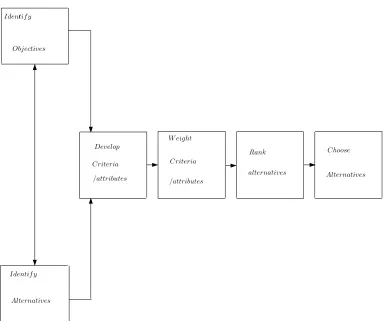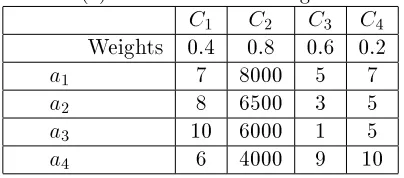Int. J. Industrial Mathematics Vol. 1, No. 1 (2009) 69-75
Sensitivity analysis for criteria values in decision
making matrix of SAW method
Abbas Toloie Eshlaghya, Nasim Rastkhiz Paydarb, Khadijeh Jodab, Neda Rastkhiz Paydard
(a) Faculty of Management and Economic, Industrial Management Department, Science and Research Branch, Islamic Azad University, Tehran,Iran. (b) M.A. Student of Information Technology Management, Islamic Azad University, Sciences and Research Branch, Faculty of Management and Economic, Tehran,Iran. (d) M.A.Student of Information Technology Management, Alameh Tbatabai University, Tehran,Iran.
||||||||||||||||||||||||||||||||{ Abstract
All of organizations around the world, try to increase competitive ability regards to other similar companies. In this way, decision making processes are one of the most impor-tant activities for help them. The multiple criteria decision making methods create for help better decision making in multidimensional environment to monitor organizational resources and, generally, for ranking them and their departments.
One of the simplest and applicable methods in multiple criteria decision making methods is SAW method (simple additive weighting method).The general problem in MADM meth-ods is lacking of complementary information for nal decision making. In optimizations methods (for example linear programming) the sensitivity analysis are used for produce complementary information and this reason helps for popularity of these methods. Al-though MADM methods don't belong optimizations methods, but in this paper try to use sensitivity analysis approach for produce complementary information by determination of criteria values domain in decision making matrix.
Keywords: Multiple criteria decision making , Ranking Methods, SAW, Sensitivity analysis. ||||||||||||||||||||||||||||||||||
1 Introduction
In world industrial revolution, especially, since World War II, most of the mathematician and management scientists pay attention to classical optimization methods with only one criterion.
They change his paradigms to complex decision making, in recent decay and monitor care-fully multi criteria decision making methods. These methods divided two main branches: MODM (multiple objective decision making) that use for designating activities and MADM (multiple attribute decision making) that use for nd priority of alternatives and ranking them. As shows in gure no.1, total process of multiple criteria decision making begins with goal and criteria determination and then if it possible; decision making matrix must be created. Development of operations follows by some preprocesses functions, for exam-ple nding the utility of criteria, dimensionless activities and the most important stage means weighting function. Decision makers must be allocated some values to criteria as its importance that calls criteria weights. At the end of these processes the rank of each criterion must be nding.
Identif y
Objectives
Identif y
Alternatives
Develop Criteria /attributes
W eight
Criteria /attributes
Rank alternatives
Choose
Alternatives
Fig. 1 Main process of multiple criteria decision making
n criteria play their roles. The weight or importance of criteria has a very important eect on these processes. The SAW Technique is a common algorithm in multiple criteria decision making approach. This method with considering a set of criteria, calculate the value of each alternative and ultimately show the ranks of all possible alternatives. Since the change of data is often a problem in MADM, so sensitivity analysis after ranking can help us to eective adoption of a correct decision. In this article a new type of sensitivity analysis will be use in MADM problems. This type of sensitivity analysis use in the SAW method (one of the popular MADM methods) and study the relations obtained it subject to with changing the values of alternatives for each of criteria an eective decision making can be gained.
At the end of article, an example, presents for show the obtained relationship and method veriability.
2 SAW technique
Compensatory models in MADM are very important in decision making because trade of between criteria is allowed. This method used to calculate each alternative values that product by criteria weights and at the end rank of them obtained. Suppose the set of alternatives are:
A = (a1; a2; : : : ; an)
Set of criteria is:
C = (c1; : : : ; cn)
And set of criteria weights are:
W = (w1; w2; : : : ; wn)
So, ranking of alternatives can be calculated as shown in table (1):
Table (1) the SAW method calculation matrix
Weights w1 w2 wj wn
alternatives/ Criteria C1 C2 Cj Cn Final Value
a1 f11 f12 f13 f1n 1
a2 f21 f22 f23 f2n 2
ai fi1 fi2 fi3 fin i
am fm1 fm2 fm3 fmn m
Which:
wj is scale less criteria weights
fij is scale less value of ith alternative for jth
i is nal value for ith alternative that calculate as below:
i = n
X
j=1
3
Sensitivity analysis
The purpose of sensitivity analysis is determining the quantity of deviation of ith alter-native value from jth criterion; subject to the arrangement of alteralter-natives ranking still remain without changes. With considering the table (1), dij dened as, amount of
devia-tion in fij, subject to the alternatives ranking still remain without change.
In this way: d+
ij is positive deviation of ith alternative from jth criterion
dij is negative deviation of ith alternative from jth criterion dij is total deviation of ith alternative from jth criterion
i+ rst dominant value into ith alternative i rst worse value into ith alternative
Since dij is total deviation of ith alternative from jth criterion, so it means distance
between d+ij and dij, so. dij will be calculated as following formula:
dij < dij < d+ij (3.2)
The d+ij through the formula no.(3.2) will be calculated as follow:
d+ij = (+i i) n
X
j=1
wj (3.3)
Similarly, the dij through the formula no.(3.2) will be calculated as follow:
dij = (i i) n
X
j=1
wj (3.4)
Considering that the changes in value of alternative with lowest rank in negative di-rection should not have any aect on ranking, so, the only restriction in negative didi-rection must be as follow:
fij+ dij 0 (3.5)
and then:
fij < dij (3.6)
Therefore changes have allowed for value of alternative with lowest rank will be:
fij dij (+i i) n
X
j=1
wj (3.7)
While changes in value of alternative with the highest rank in positive direction have not any aect on ranking, therefore, the changes have allowed the value of ith alternative for jth criterion with the highest rank is:
(i i)
n
X
j=1
4 Case study
Executive Managers in information technology projects, for implementation of manage-ment information systems, are trying to select the best contractor between four contrac-tors.In this way, four people as experts, have to do this decision making.Criteria are includ-ing, time to complete the project (C1), commissioning costs (C2), Contractors records for
projects implementation (C3) and workforce capability (C4). Table (2) is initial decision
making matrix for the best contractor selection. The matrix includes integrated opinions of each four experts. Numbers within the matrix represent the amount of raw values and the rst row represent of each criterion weights.
Table (2) initial decision making matrix
C1 C2 C3 C4
Weights 0:4 0:8 0:6 0:2
a1 7 8000 5 7
a2 8 6500 3 5
a3 10 6000 1 5
a4 6 4000 9 10
First of all, the decision making matrix must be changes in scale less form, by probability scale less method. Table no. 3 shows the scale less decision making matrix. The row of weights should be done in same manner.
Table (3) scale less decision making matrix
C1 C2 C3 C4
Weights 0:2 0:4 0:4 0:1
a1 0:226 0:327 0:278 0:259
a2 0:258 0:265 0:165 0:185
a3 0:323 0:245 0:056 0:185
a4 0:194 0:163 0:500 0:370
Total value for each alternative regards to formula no.(2.1) can be nd and the results is as follow (Rounded to 3 digits ):
1= 0:285; 2 = 0:226; 3 = 0:198; 4= 0:291
So, the ranks of all alternatives are:
4> 3 > 2 > 1
Since the company policy is permanent connection with information systems contractors and also for produce some extra operational, and also for obtain some extra operational and executive information about them, sensitivity analysis may be useful. Sensitivity anal-ysis table is produce regards to above formula. Results have been shown in table no.(3); we can see the domain of each fij. For example the allowable deviation for alternative a1
for criterion C1 is about 0:03 in positive direction (it means that value can be increase)
Table (3) total deviations for each value of nal decision making matrix
C1 C2 C3 C4
a1 0:294 < d11< 0:030 0:147 < d12< 0:015 0:196 < d13< 0:020 0588 < d14< 0:060 a2 0:0143 < d21< 0:294 0071 < d22< 0:147 0:095 < d23< 0:196 0:286 < d24< 0:588 a3 0:323 < d31< 0:143 0:245 < d32< 0:071 0:056 < d33< 0:095 0:185 < d34< 0:286 a4 0:030 < d41 0:015 < d42 0:020 < d43 0:060 < d44
In this paper should be noted that sensitivity analysis briey introduced for value of alternatives in SAW method. Sensitivity analysis for the weights and also, for other MADM methods will be discussed in next papers.
5 Conclusion
This article introduced sensitivity analysis in SAW method. In SAW method, alternatives ranks regards to criteria. This method is one of the individual, multiple criteria decision making methods but simply can be used for group decision making. Also, criteria weights can be nding with various methods. After obtaining alternatives rank, managers need to nd the sensitivity of values and also, the domain of deviations in decision making matrix. This paper shows that by sensitivity analysis, decision makers can nd extra information as decision supports, without any changes in alternatives ranking.
In this article, a new method for sensitivity analysis of numerical values in decision making matrix is presented, and also a case study done for model verication.
References
[1] A Dynamic Objective-Subjective Structure for Forest Management with Focus on Environmental Issues. Journal of Multi-Criteria Decision Analysis, 14, 2006, 55-65. (With A. Weintraub).
[2] Akgl, M., 1984, a note on shadow prices in linear programming. Journal of the Op-erational Society, 35 (5), 425-431.
[3] Aucamp, D. C. and Steinberg, 1982, the computation of shadow prices in linear Programming. Journal of the Operational Research Society, 33 (6), 557-565.
[4] Caine, D. J. and Parker, B. J., 1996, linear programming comes of age: a decision Support tool for every manager. Management Decision, 34 (4), 46-53.
[5] Doumpos, M. and Zopundnidis, C. (2002). Multicriteria Decision Aid Classication Methods. Kluwer Academic Publisher, Dordrecht.
[6] Dyer, R.F. and Forman, E.H. (1992). Group decision support with the analytic hier-archical process. Decision Support Systems 8, 99-104.
[7] Dynamic Decision Problem Structuring, Journal of Multi-Criteria Decision Analysis, 10, 2001, pp. 129-141 (with J. Corner and J. Buchanan).
[9] Gal, T., 1986, Shadow prices and sensitivity analysis in linear programming under degeneracy. OR Spektrum, 8, 59-71.
[10] Eom, S.B. and Min, H. (1999). The contributions of multicriteria decision making to the development of decision support systems subspecialties: An empirical investiga-tion. Journal of Multicriteria Decision Analysis 8, 239-255.
[11] Hadigheh, A. G., Mirna, K., and Terlaky. T., 2007, Active constraint set invariance sensitivity analysis in linear optimization. Journal of Optimization Theory and Ap-plications, 133 (3), 303-315.
[12] Hadigeh, A. G. and Terlaky, T., 2006, Sensitivity analysis in linear optimization: Invariant support set intervals. European Journal of Operational Research, 169, 1158-1175.
[13] Hwang, C.L. and Masud, A.S.M. (1979). Multiple Objective Decision Making: Meth-ods and Applications. Spring-Verlag, New York.
[14] Hwang, C.L. and Yoon, K. (1981). Multiple Attributes Decision Making Methods and Applications. Springer-Verlag, Berlin, Heidelberg.
[15] Jansen, B., De Jong, J. J., Roos, C., and Terlaky, T., 1997, Sensitivity analysis in linear programming: Just be careful. European Journal of Operational Research, 101, 15-28.
[16] Keeney, R. and Raia, H. (1976). Decision with multiple objectives: Preference and value tradeos. New York, Wiley and Sons.
[17] Koltai, T. and Terlaky, T., 2000, the dierence between the managerial and mathe-matical interpretation of sensitivity analysis results in linear programming Interna-tional Journal of Production Economics, 65, 257-274.
[18] Raggsdale, C. T., 2007, Managerial Decision Modeling, Thomson.

